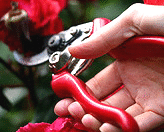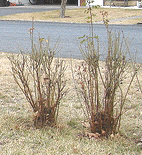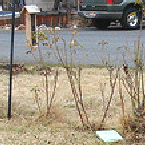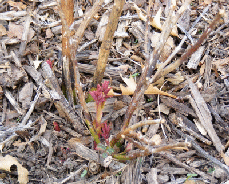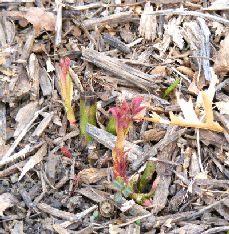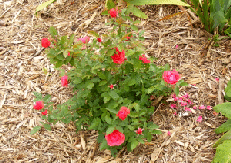Rose Pruning: An Easy to Understand Guide
It’s no wonder gardeners are intimidated by rose pruning instructions when terms like “secateurs” and “nodes” are thrown around without explanation or definition.
Rose pruning on the surface seems too complicated, and gardeners abandon the idea of growing roses, especially when they are already combatting the cold climate of the north or midwest.
But the truly complicated methods were developed by rosarians whose objective is to produce very specific qualities in the blooms and stem length.
Most gardeners just want to produce more flowers on a healthy plant, so pruning is pretty simple once you understand a few basic principles - And don’t worry about doing it “right”.
When you first start pruning roses, if you don’t prune enough, you may not get as many blooms. If you prune too much, roses can take it!
You will probably get more blooms, even if you haven’t produced the size or fullness you may prefer in the plant. And if it takes you more than 10 or 15 minutes to prune a rose bush, you are being much more careful than you need to be.
Why Prune Roses
To keep roses healthy, the most important task is pruning.
Any canes that are dead, weak, damaged, or diseased should be removed to prevent disease or fungus from spreading to the plant.
Pruning out canes from the center of the rose bush will improve air circulation, which will, in turn, help prevent mildew and fungus.
Additionally, an open center discourages insects from making it their home.
Pruning also serves to promote more blooms or to strike a balance between blooms and foliage depending on the type of rose and the gardener's preference.
Finally, pruning may be done to maintain a specific size or shape of the rose bush.
When to Prune Roses
Determining when to prune roses can be tricky. Most rose pruning is typically done in the spring, regardless of the objective, whether it's cleaning up and thinning, shaping, or promoting flower production.
But when exactly is spring?
Recommendations vary widely, from when the forsythia blooms (not always a helpful indicator) to January, May, or when the frost goes out. The right time to prune depends on your location.
A good rule of thumb is to prune after the last hard frost once the soil has started to warm up and early spring bloomers like forsythia have begun to flower.
Pruning stimulates growth, so new shoots exposed to winter winds or late frost can be damaged.
If you live in the northern zones of the Midwest, you likely pruned back larger rose bushes as part of your winter protection. But it's important not to remove winter protection too soon, as this could trigger new growth that may be damaged by late frost.
Keep your winter protection in place until the soil temperature is warm enough to start growth on the earliest plants, which can vary by region and year.
For instance, in Minnesota, this may be mid-April to mid-May, in Rhode Island, it may be late April, in Missouri, perhaps early April, and in North Carolina, late February or early March.
Be patient and wait until the ground has warmed up to start removing your protection and pruning. Pruning too early can be disastrous, as late frost damage can severely limit blooming.
Tools for Pruning Roses
To protect yourself from thorns while pruning roses, it's a good idea to wear heavy rose gloves and long sleeves to cover your arms when reaching inside the rose bush. Consider using elbow-length gauntlet gloves for added protection.
You'll also need a sharp rose pruner, ideally a bypass pruner that features curved blades that slide past each other, like scissors, for a clean cut. This type of pruner is often referred to as secateurs by rosarians.
While they're strong enough to prune hard branches, large old canes may require a fine-toothed pruning saw or long-handled loppers.
Loppers are similar to hand pruners, but feature longer handles to provide more leverage on thick branches and larger blades.
Remember to clean the blades after each use to prevent the spread of disease or fungus they may have come into contact with.
You can use hydrogen peroxide or diluted bleach or alcohol to disinfect the tools, either by dipping them or wiping them down with a clean cloth.
Finally, to seal cuts and prevent disease and insects from entering, consider using a commercial sealer designed for this purpose or Elmer's white glue.
Simply apply a thin coat over the cut with your finger. With these tools and precautions, you can safely and effectively prune your roses.
Getting Started
To ensure proper pruning, hold the pruner with the cutting blade down at a 45-degree angle, a quarter inch above a leaf bud or node that faces outward from the plant.
Angling the cut-down and away from the node allows water to run off instead of being trapped.
Begin by removing all dead, dying, or damaged canes, which will appear shriveled, dark, or black. Then remove any weak canes that are thinner than a pencil.
Suckers, which are new plant shoots from the roots, should not be cut, as cutting them will encourage several more suckers to grow from the cut. Instead, remove the soil to expose the sucker to its base and pull it down and away from the root.
If your rose bush is grafted, any suckers produced will not resemble the bush you have. For own-root roses, they generally do not produce suckers.
After these initial steps, you can move on to shaping the rose bush and pruning it to produce blooms.
The instructions for shaping and pruning vary depending on the variety of rose bushes you have.
Is my rose bush dead?
First, be patient when evaluating your rosebush's health after a harsh winter. Sometimes, the rosebush may just need more time to recover. Pruning it down to the ground might not be the best option.
Pruning to Force Growth
If it's been a while since other plants have started to bud, and there is still no sign of life from the rosebush, prune it down to six inches. This will sometimes encourage growth from struggling canes.
Identifying Dead Canes
If there is still no sign of life, check to see if the canes are dead. If the rosebush is an "own root" hardy rosebush, sprouts may appear from the rootstock.
Pruning Dead Canes
If sprouts have appeared from the canes, prune to the growth buds that are showing life. If there is no life, prune all canes to the bud onion in another attempt to force growth from the rootstock.
Evaluation of Winter Protection
If none of these methods work, it is possible that the rosebush was not hardy enough for your zone, or you did not provide adequate winter protection.
The explorer rose shown earlier was pruned down to the ground after a harsh winter. It forced new shoots after all the canes were cut way back, and the dead canes were removed. Several weeks later, it has grown nearly as large as it was last year and is blooming beautifully.
Final Spring Pruning Instructions by Rose Type:
Pruning Rugosa Roses
Pruning is mainly done to shape or thin out the plant by removing canes at the base for thinning or a portion of canes for shaping.
During the first year, the plant can be pruned aggressively in the fall by shearing it down to 8-12" to create a fuller shrub. However, excessive pruning can lead to fewer blooms.
Pruning after the last bloom will result in the loss of colorful hips during the winter.
If you don't want to control the plant's size or height, you can skip the final pruning altogether.
Pruning Shrub Roses - Repeat Bloomers
Shrub roses of modern varieties bloom on mature wood but not on old, woody wood. To ensure optimal growth, allow the shrub to mature for two to three years before starting the "one-third" pruning method.
This involves removing one-third of the oldest canes, and further removal can be done at your discretion based on your personal preference and the fullness of the shrub.
You can leave as many canes as necessary to fill the space. As a maximum, select one-third of the youngest canes from the previous year and remove all others.
Pruning Portland & Bourbon Roses - Repeat Bloomers
These roses are capable of blooming on both old and new wood. After the first bloom, any pruning beyond deadwood removal should be done only for shaping, reducing height, or thinning according to your preferences.
Because they bloom on both old and new wood, pruning becomes a matter of personal preference and experience. If necessary, these roses can be pruned aggressively in the early spring.
Pruning Old Garden Roses
The Albas, Centifolias, Damasks, Gallicas, and Mosses are single-blooming roses that produce flowers on old wood.
After the spring bloom, pruning can be done according to your preferences, such as removing old wood to promote new growth or shortening long shoots by a third.
If you have a Damask that reblooms, prune it like a hybrid tea rose. If you have a Moss Rose that reblooms, prune it while it is dormant by cutting back half of the plant and removing some old wood at the base.
Focus on shaping and thinning, as they are very vigorous bushes.
Pruning Polyantha Roses
When pruning polyantha roses, it is best to do so while the plants are dormant, leaving an open structure of strong young canes.
Start by removing all dead or damaged canes, then cut back one-fourth to one-third of the remaining canes' length. This can be done easily by shearing with a hedge shear.
Polyantha roses are typically compact and well-behaved, so there is no need to prune heavily unless you want to control the size and shape of your plant. Simply removing dead and damaged wood may be sufficient.
Throughout the season, you may remove spent blooms if desired. Deadheading can also be done easily with a hedge shear.
Although deadheading may encourage reblooming, polyanthas tend to rebloom steadily even without deadheading.
Pruning China Roses
Prune while the plants are dormant only to lightly shape them.
Pruning Miniature Roses
Early in spring, just trim with a garden clipper to about 8 to 15 “ tall.
Pruning Easy Elegance Roses
In the first season, Easy Elegance roses typically do not require much, if any, pruning. Simply remove any dead or damaged canes using sharp pruners.
Once the plant is established, continue to remove any dead or damaged canes, and maintain good air circulation by pruning out crossing canes and inward-growing canes to keep the center of the plant open.
As the plant matures, pruning the oldest canes to one-third of their size will promote new growth and more blooms. Always prune in early spring before growth begins or in winter after the plant has gone dormant.
Dead and damaged wood should be removed immediately, regardless of the time of year. Deadhead spent blooms to encourage reblooming.
Pruning Modern Ever-Blooming & Floribunda Roses
To encourage optimal growth, reduce the number of canes to 3 to 6, evenly spaced. These plants mainly bloom on new growth, so they can be pruned hard down to 18 to 30 inches.
Some gardeners choose to cut back at varying lengths to promote blooming at different times.
Pruning Hybrid Tea Roses, Grandifloras & Hybrid Perpetuals
Similar to other plants that bloom on new wood, pruning for these plants should be done in early spring.
To create an open vase shape, remove all center canes and leave 4 to 6 canes. Some gardeners may choose to leave as many canes as possible as long as they promote excellent air circulation.
Cut back to about half, or 18 to 36 inches, based on your preference.
Pruning And Training Climbing & Rambling Roses
Vining roses come in two types, climbing or rambling, which are similar in many ways.
Climbing Roses
Climbing roses are usually 8-10 feet tall and require support such as a trellis. Most bloom at least twice between early summer and early fall, but new varieties can bloom continuously.
Supporting Climbing Roses
Climbing roses need to be tied in place. Plastic garden tape can be used to secure three or four primary canes. Tie tape or twine tightly to the support structure and then loosely to canes.
Pruning Climbing Roses
Climbing roses need a couple of years to mature before doing too much pruning. Early spring pruning should be limited to removing winter damage and dead canes, then reducing side/lateral shoots to 3 to 6 inches to increase flower production. After flowering, prune only to maintain size and shape.
Don't let a climber grow too tall too fast or it will bloom primarily at the top. Keep it shorter at first until the bottom fills out, letting it grow taller over time.
Be careful not to prune too much new growth, on top or the laterals, as hard pruning will limit the bloom period since the first bloom is on old wood, then on newer growth.
Rambling Roses
Rambling roses can reach 15-25 feet tall and usually only bloom once. However, they produce a profuse amount of flowers for a longer period than climbers, anywhere from 3 to 6 weeks. Once-blooming roses are typically more robust and resistant to diseases.
Supporting Rambling Roses
Rambling roses grow thick and sturdy and usually only need to be trained for the first couple of years. Plastic garden tape can be used to secure three or four primary canes, or twine can be used but will need to be replaced every few years. The wire in garden twist ties can cause enough damage to kill canes. Tie tape or twine tightly to the support structure and then loosely to canes.
Pruning Rambling Roses
Rambling roses need regular pruning as they grow vigorously and can become tangled. In spring, prune only to remove dead canes and winter damage, and if necessary, to reduce size or trim shape. After blooming, you may prune as much as you like, all the way down to a few inches if you like, or simply remove the oldest wood to produce new growth, saving a few main canes. Then do what looks good.
